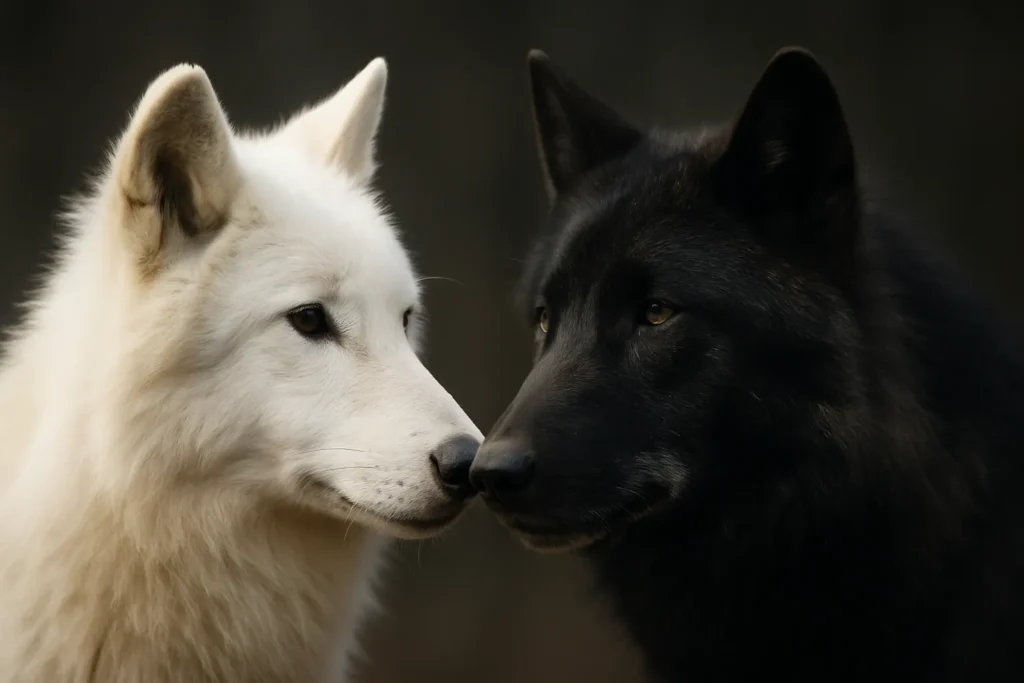You’ve probably heard the phrase “white wolf dark wolf” or maybe the popular line, “the one you feed.” It’s one of those stories that sticks in your head because it feels so true to daily life. We all carry moments of kindness and patience, but also sparks of anger or jealousy. The legend of the two wolves puts that struggle into a simple but powerful image: inside us live two wolves—one light, one dark—and the one that grows stronger is the one we choose to feed.
Here’s the thing: this isn’t just a motivational quote floating on Instagram. It comes from an old Cherokee tale that’s been told for generations, though its origins and authenticity are often debated. What makes it powerful is how easily it connects with our personal experiences. Think about the last time you had to decide between snapping at someone in anger or taking a deep breath and responding calmly. In that moment, you’re feeding one of the wolves.
In this article, we’ll dive deep into the white wolf dark wolf story—where it came from, what it means, how people interpret it today, and even how it shows up in tattoos, art, and personal growth. We’ll also talk about some common misunderstandings and why balance might be more important than picking just one side.
Snippet-Ready Definition
The white wolf dark wolf story is an allegory about inner conflict. One wolf represents negative traits, the other positive. The one you feed with your choices and actions becomes stronger.
The Origins & Authenticity of the Legend
The Cherokee Elder and Grandson Story
The most common version of the black wolf and white wolf story goes like this: An old Cherokee elder is teaching his grandson about life. He says, “There’s a battle going on inside me. It’s between two wolves. One is evil—full of anger, greed, envy, arrogance. The other is good—full of peace, love, hope, kindness, and faith.”
The grandson listens carefully and then asks, “Which wolf will win?” The elder replies simply: “The one you feed.”
It’s short, almost like a parable, but it hits deep because it explains human behavior in such a visual way. Everyone can imagine two wolves locked in a fight inside them.
Variations of the Tale
Not all versions call them “white wolf and dark wolf.” Some say black wolf and white wolf. Others use light wolf and shadow wolf. In modern retellings, people even adapt the animals or the context, but the message usually stays the same—our choices shape which qualities become stronger in us.
Interestingly, some storytellers have added their own spin: instead of only feeding the white wolf, some suggest you need to feed both. Why? Because ignoring your darker side can create more problems. We’ll dig into that interpretation later.
Authenticity: Cherokee or Not?
Now, here’s a point that many skip: there’s debate over whether this story is truly Cherokee in origin. Some Native American scholars argue that while it reflects Native themes of balance and duality, there’s little evidence it’s an authentic, traditional Cherokee tale. Instead, it may have gained popularity through books, speeches, and eventually social media memes.
That doesn’t mean it’s worthless. Even if the exact origin is fuzzy, the allegory has spread globally because it resonates with something universal—the inner battle between positive and negative traits. Still, it’s important to acknowledge the cultural sensitivity here. When retelling the white wolf dark wolf story, we should respect Native traditions and avoid claiming it as purely Cherokee without proper sources.
Cross-Cultural Parallels
This isn’t the only culture to express inner conflict through animals or duality. For example:
- In Chinese philosophy, yin and yang describe the balance of opposites—light and dark, passive and active, good and bad.
- In psychology, Carl Jung spoke about the “shadow self,” which is the darker side of our personality we must understand and integrate.
- In many religions, the battle between good and evil, spirit and flesh, is a recurring theme.
So while the white wolf dark wolf meaning may not belong exclusively to one culture, it fits into a much larger human story about choice, morality, and self-awareness.
Symbolism of the White Wolf and Dark Wolf
When you hear white wolf and dark wolf, it sounds almost like characters out of a fantasy novel. But in the legend, they’re not outside creatures—they’re symbols of what’s already inside us.
The Dark Wolf
The dark wolf is often called the black wolf or shadow wolf. It represents the emotions and behaviors that pull us down:
- Anger that makes us lash out at people we love.
- Greed that makes us never satisfied with what we already have.
- Fear and doubt that stop us from chasing opportunities.
- Envy that poisons friendships.
- Arrogance that blinds us to learning.
In real life, feeding the dark wolf means repeating these patterns until they become habits. Imagine someone who always responds to stress by blaming others or shutting down. Over time, that wolf becomes strong enough to control most of their life.
The White Wolf
The white wolf symbolizes the qualities we admire in others—and hope to see in ourselves:
- Peace in the middle of chaos.
- Love and compassion toward family, friends, even strangers.
- Humility that keeps us grounded.
- Faith and hope that push us through dark times.
- Kindness that creates connection.
Feeding the white wolf means practicing these values until they become second nature. Think about someone who’s patient with a difficult coworker or who chooses forgiveness over holding a grudge. That’s the white wolf at work.
Psychological and Spiritual Lens
Here’s the thing: most modern experts in psychology and spirituality agree—it’s not about killing one wolf. Carl Jung would call the dark wolf your shadow self. If you deny it or pretend it doesn’t exist, it only grows more dangerous. The wiser approach is awareness: notice both wolves, then make conscious choices.
Spiritually, many traditions echo the same truth. Balance matters. Light has no meaning without darkness. Joy feels richer after sadness. Feeding the white wolf doesn’t mean ignoring the dark—it means choosing what you nurture while still acknowledging your full humanity.
“The One You Feed”: The Core Moral
The famous line—“Which wolf wins? The one you feed”—is the heart of the story. But like most wisdom, it has layers.
The Literal Meaning
On the surface, the lesson is simple: the habits, thoughts, and choices you repeat become stronger. If you constantly give attention to anger or fear, those traits dominate. If you keep practicing kindness and gratitude, they grow.
It’s like exercise. Feed the “muscles” of patience and compassion, and they’ll carry you further. Neglect them, and the muscles of resentment and envy take over instead.
The Deeper Interpretation
Here’s where many people stop—but there’s more. Some versions of the story suggest that starving the dark wolf isn’t the answer either. Why? Because your “dark wolf” contains raw energy that, when understood, can be transformed. Anger can fuel justice. Fear can sharpen awareness. Even envy can reveal what you truly want in life.
So, the real power lies not just in feeding the white wolf, but in choosing how you feed both. You can guide the dark wolf, tame it, and turn its strength into something useful instead of destructive.
When One Wolf “Wins” in Daily Life
You don’t need a big dramatic moment to see which wolf you’re feeding. It happens in tiny, everyday choices:
- Do you snap at a family member when you’re stressed—or pause and explain calmly?
- Do you hold on to jealousy about a friend’s success—or let it inspire you?
- Do you dwell on fear—or take a small step forward anyway?
Each decision, however small, is like tossing food to one wolf or the other. And guess what? Those little feedings add up to the life you build.
How to Feed the White Wolf: Practical Life Applications
It’s one thing to admire the story of the white wolf dark wolf—but the real challenge is living it. The good news? Feeding your white wolf doesn’t take grand gestures. It’s in the little choices you make every single day.
Daily Mindset Practices
The easiest way to strengthen your white wolf is by practicing habits that nurture positivity. Here are a few simple ones:
- Gratitude journaling: Write down three things you’re thankful for each morning. It shifts your focus away from scarcity (the dark wolf’s favorite food).
- Mindful pauses: Before reacting in anger, take one deep breath. That pause often decides which wolf gets fed.
- Acts of kindness: Even small gestures—like holding a door, or complimenting someone’s effort—are meals for the white wolf.
The best part is, these practices don’t just make you feel better—they create ripples. A kind word at the right time can change someone else’s whole day.
Coping with Dark Emotions
Here’s the thing: feeding the white wolf doesn’t mean starving the dark wolf until it disappears. Negative emotions are part of being human. What matters is how you respond.
- When anger shows up → use it as a signal. Ask, “What boundary was crossed?” Instead of lashing out, channel it into assertive but calm communication.
- When fear creeps in → remind yourself fear is a natural alarm system. Use it to prepare wisely, not to paralyze yourself.
- When envy bites → see it as a clue. Maybe it’s pointing to something you truly desire and need to work toward.
So, the dark wolf isn’t your enemy. It’s a wild teacher that, if handled wisely, can guide growth.
Real-Life Reflection
Think about the last time you were caught in traffic. The dark wolf feeds on road rage—yelling, honking, feeling miserable. The white wolf chooses patience—turning on a podcast, or using the time to breathe. Same situation, two totally different experiences. Which wolf you feed is always your choice.
Misunderstandings & Cautions
Like many stories that spread on social media, the black wolf and white wolf story can sometimes get twisted. Let’s clear up a few common misunderstandings.
Oversimplifying Human Psychology
Some people take the story too literally, as if you can just “starve out” negativity. But psychologists point out that denying your shadow emotions often makes them stronger. True growth comes from acknowledging them, then guiding them.
Ignoring the Shadow Self
Carl Jung, the famous psychologist, warned that suppressing the shadow self—your dark wolf—can lead to explosive or harmful behavior later. If you pretend you never feel anger, envy, or fear, those feelings don’t vanish. They just go underground. And when they resurface, they can be harder to control.
Cultural Sensitivity
Another caution: while often credited to the Cherokee, some Native voices argue the story has been over-simplified or misattributed. For non-Natives, it’s important to treat the tale with respect and not use it in a way that disrespects its possible cultural roots.
Misuse in Pop Culture
The line “the one you feed” is so catchy that it’s used everywhere—motivational posters, tattoos, even memes. While that spreads the message, it sometimes strips away the depth. If you only focus on “kill the dark wolf, feed the white,” you miss the richer lesson of balance and integration.
The White Wolf & Dark Wolf in Popular Culture and Art
The white wolf dark wolf story has moved far beyond oral tradition. Today, it shows up in tattoos, artwork, films, and even motivational speeches. Each version shows how deeply people connect to the idea of inner conflict.
Tattoos and Designs
One of the most common expressions is through white wolf and black wolf tattoos. People ink these symbols to remind themselves of the battle inside. Some designs show the wolves locked in combat, while others portray them side by side—representing balance.
- Black wolf white wolf designs often use sharp contrasts—dark ink for the shadow, bright highlights for the light.
- For many, it’s not just art—it’s a personal commitment to feed the right wolf.
Pictures and Artwork
Artists also love to explore the contrast visually. Black and white wolf pictures symbolize the pull between two forces. Photographers even capture wolves in snow and shadow to reflect the metaphor.
Social media platforms are filled with stylized images of wolves paired with the famous line: “Which one wins? The one you feed.” Even though it’s overused at times, the imagery remains striking.
Pop Culture and Storytelling
Movies and books often borrow the theme without naming it directly. Anytime you see a character torn between revenge and forgiveness, you’re watching the same metaphor in action. Motivational speakers also use the story to teach about self-discipline, addiction recovery, or leadership.
And guess what? Even if some people roll their eyes at clichés, the truth is the story sticks because it’s simple enough to remember but deep enough to live by.
Comparison Table: White Wolf vs Dark Wolf
| Aspect | White Wolf (Positive) | Dark Wolf (Negative) |
| Traits | Peace, love, kindness, humility, hope | Anger, envy, greed, arrogance, fear |
| Outcome if Fed | Growth, balance, happiness, resilience | Conflict, stress, destructive habits |
| Symbolism | Light, compassion, higher self | Shadow, ego, darker instincts |
| Real-Life Example | Forgiving a friend | Holding grudges & resentment |
Bullet List: How to Feed the White Wolf
- Practice gratitude daily
- Respond calmly instead of reacting in anger
- Show kindness in small acts
- Use fear as a signal, not a roadblock
- Surround yourself with positive influences
FAQs: Common Questions About the Two Wolves
Q1: What is the real story of the two wolves?
It’s often told as a Cherokee legend where a grandfather explains the battle inside us between two wolves—one dark, one light. The grandson asks, “Which wolf wins?” The answer: “The one you feed.”
Q2: What does white wolf dark wolf meaning really imply?
It’s a metaphor for the choices we make in life. Every thought and action strengthens either our negative traits (the dark wolf) or our positive ones (the white wolf).
Q3: Why do people get white wolf and black wolf tattoos?
Because it’s a visual reminder of inner strength, balance, and the battle between light and dark within. For some, it marks recovery from hardship or a personal turning point.
Q4: Is the story only about feeding the white wolf?
Not exactly. While the popular version says “feed the white wolf,” many modern interpretations suggest acknowledging both. The dark wolf has lessons too—it teaches resilience, awareness, and boundaries.
Q5: Is the legend truly Cherokee?
There’s debate. Some say it’s Cherokee, others argue it’s a modern adaptation. What’s important is to honor indigenous traditions and avoid presenting it as fact without context.
Q6: What does the white wolf dark wolf story mean?
It’s a metaphor for inner conflict. The wolf you “feed” with your actions—positive or negative—becomes stronger.
Q7: Is the white wolf dark wolf story Cherokee?
It’s often attributed to Cherokee tradition, but its exact origin is debated. Still, it carries universal wisdom about human choice.
Q8: Which wolf wins in the legend?
The one you feed. Your habits and focus decide whether positive or negative traits dominate your life.
Q9: What is the lesson of the two wolves?
The lesson is self-awareness: you control which qualities you nurture. Positive habits lead to growth, while negative focus leads to struggle.
Q10: Why do people get white wolf and black wolf tattoos?
Tattoos symbolize personal growth, inner struggle, or a reminder to choose kindness and balance in life.
Conclusion: Choosing What You Nourish Inside
At its heart, the white wolf dark wolf story is about choice. Every day, in small and big ways, you’re deciding which wolf to feed. Do you give energy to anger, fear, and envy? Or do you nurture patience, kindness, and love?
Here’s the thing: life isn’t about killing one wolf and glorifying the other. It’s about balance. The dark wolf will always be part of you, but you don’t have to let it run the show. The white wolf grows stronger with every act of compassion, every moment of gratitude, every choice to pause instead of explode.
The best part is, you’re never stuck with yesterday’s choices. Each new day, each moment, is another chance to feed the wolf that leads you closer to the person you want to be.
So next time you catch yourself at a crossroads—between bitterness and kindness, fear and courage—remember the question the grandson asked: “Which wolf will win?”
And remember the answer: “The one you feed.”
Disclaimer
This article is for educational and inspirational purposes only. While the white wolf dark wolf story is often linked to Cherokee tradition, its origins are debated. We aim to share the story respectfully and encourage readers to use it as a metaphor for personal growth, not as a historical or cultural fact.

Hi, I’m Bilal, the founder of outofmagazine.com. I love sharing fresh ideas, stories, and helpful insights on all kinds of topics that spark curiosity. My goal with this site is simple—to create a space where readers can find inspiration, useful tips, and engaging reads on lifestyle, trends, and everything in between.



